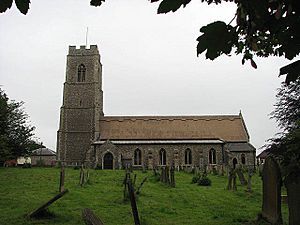John Alen facts for kids
Quick facts for kids John Alen |
|
|---|---|
| Archbishop of Dublin Primate of Ireland |
|
| Church | Roman Catholic |
| Archdiocese | Dublin |
| Appointed | 3 September 1529 |
| In Office | 1529-1534 |
| Predecessor | Hugh Inge |
| Successor | George Browne |
| Other posts | Lord Chancellor of Ireland |
| Orders | |
| Ordination | 25 August 1499 |
| Consecration | 13 March 1530 |
| Personal details | |
| Born | 1476 Coltishall, Norfolk, England |
| Died | 28 July 1534 Clontarf, Dublin, Ireland |
| Nationality | English |
John Alen (born 1476 – died 28 July 1534) was an English priest and a canon lawyer. He spent his later years working in Ireland. He held important jobs like Archbishop of Dublin and Lord Chancellor of Ireland. He was also a member of the King's special council in Ireland. For a few years, he was very important in how Ireland was governed.
He was killed during a rebellion led by "Silken Thomas" Fitzgerald. Thomas wrongly believed that Alen was responsible for his father's death. However, Thomas's father had died naturally. Even though Thomas was angry, he always said he didn't mean to kill Alen. He claimed his order, given in Irish, to "take him away" was misunderstood as a command to kill him.
Contents
Early Life and Education
John Alen was born in 1476 in Coltishall, Norfolk, England. His father was Edward Alan, and his mother was Catherine St. Leger. Many of his relatives, including six cousins, also moved to Ireland. Some of them became important officials too.
John Alen studied at both Oxford and Cambridge Universities in England. He then spent several years in Italy, including time in Rome. There, he continued his studies and worked for Archbishop Warham of Canterbury.
Becoming a Priest
John Alen became a priest on 25 August 1499. For many years, he worked in different local churches. Around 1522, he caught the attention of Cardinal Wolsey, a very powerful church leader. Alen helped Wolsey close down smaller monasteries. Some people complained about how he did this.
Career in Ireland
Alen continued to advance in his church career. He also helped Cardinal Wolsey with his special duties as a papal representative. In 1527, he helped Wolsey in a case about King Henry VIII's marriage. In August 1528, John Alen was given the important job of Archbishop of Dublin.
Soon after arriving in Ireland, he was also made Lord Chancellor of Ireland. For a short time, Alen was a very powerful figure in the Irish government. He was one of three main leaders on the King's special council in Ireland. However, his power lessened after Cardinal Wolsey lost his influence in England.
In 1532, Gerald FitzGerald, 9th Earl of Kildare used his influence to have Alen removed from his role as Lord Chancellor.
The Rebellion of Silken Thomas
John Alen had been a supporter of Cardinal Wolsey. Because of this, he was disliked by the powerful FitzGerald family, especially the followers of the Earl of Kildare. The 9th Earl of Kildare had been imprisoned in the Tower of London by Wolsey. He was later imprisoned again by the King in 1534.
A false rumor spread in Ireland that the Earl had been killed. In response, the Earl's son, "Silken Thomas," started a rebellion in 1534.
Archbishop Alen's Murder
The Archbishop knew that Dublin Castle might be attacked during the rebellion. He tried to escape to England by boat from Dame Gate. However, his boat was forced ashore near Clontarf. He then sought safety at the home of his friend Thomas St. Lawrence at Artane Castle, near Dublin.
Sadly, his hiding place was revealed. Lord Thomas arrived at the house, chasing after him. The Archbishop was dragged out and begged for mercy on his knees. Archbishop Alen was killed by two of "Silken Thomas" Fitzgerald's men, John Teeling and Nicholas Wafer, at Artane Castle on 28 July 1534.
There is a debate about whether Silken Thomas actually ordered the killing. A well-known story says that Teeling and Wafer misunderstood his command in Gaelic. He supposedly told them to "take this fellow away," but they thought he meant to murder him. Lord Thomas later insisted he only wanted the Archbishop taken into custody. He even sent his chaplain to Rome to ask for forgiveness for the murder.
About John Alen
Sir James Ware, a historian, described Alen as a "turbulent spirit." However, he also said Alen was a welcoming person, very learned, and keen on studying old records.
His Writings and Records
John Alen wrote a paper about the pallium, which is a special symbol worn by archbishops. He also wrote another paper about rules for legal cases involving guardians. He was very organized. In the archives of the Anglican archdiocese of Dublin, there are two important record books he created.
These books are called the Liber Niger (Black Book) and the Repertorium Viride (Green Repertory). They were named after the color of their covers, as was common back then. The Black Book is a collection of the archdiocese's most important documents. The Green Repertory is a list of all the parishes in the archdiocese as they were in 1530.



